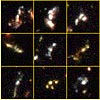| . |  |
. |
Boulder CO (SPX) Feb 20, 2006 Scientists said they have developed a new model to explain why a powerful type of cosmic radiation is largely absent from a location at the edge of the solar system that was thought to be its source. The area is called the termination shock, and the Voyager 1 spacecraft passed through the blunt nose of the region in December 2004 without detecting the phenomenon, called anomalous cosmic rays. The termination shock is the boundary where the outward force of the solar wind, traveling at about 1-million miles per hour, is equaled by inbound cosmic rays from interstellar space. That collision zone is where physicists long had anticipated they would discover the energizing source of the cosmic rays. The problem was that the rays, among the most powerful particle radiation in the solar system, were mostly no-shows at the termination shock, and therefore Voyager 1's data rendered 20 years of predictions about them wrong. David McComas of the Southwest Research Institute and Nathan Schwadron of Boston University said the termination shock's shape is the key to understanding how and where anomalous cosmic rays are energized. Writing in the Feb. 17 issue of Geophysical Research Letters, they added that it might even be a stepping stone to understanding the influence of shock shapes on energizing particle radiation throughout the cosmos. "Models showed we should see the source energy spectrum of anomalous cosmic rays at the termination shock," McComas said. "We were pretty sure we knew what we'd see, but when we got there it wasn't what we expected and it clearly was not the source of the anomalous cosmic rays." He said scientists were uncertain even where the termination shock would be found, but they knew there would be a jump in magnetic fields, a deceleration of plasma and other signs. "It's like walking across a field when you don't know where the edge of the property is," he added. Voyager 1 did not find the edge of the property, either, because it failed to detect energetic anomalous cosmic rays when it crossed the termination shock. "The 20-million-electron-volts-per-particle helium that we saw was less than 10 percent of what was predicted," McComas said. "Similarly, we saw only 5 percent of what was predicted for 4-million-electron-volts-per-particle oxygen. We weren't off by 5 or 10 percent - we were off by factors of 10 and 20." Eventually, McComas and Schwadron discovered that the problem had to do with the concept of the termination shock's shape. Most researchers had been visualizing it as spherical, with the magnetic field from the solar wind expanding outward uniformly. "In fact, the termination shock couldn't be circular because the solar system is moving through the galaxy, which would create more of a flattened egg shape," Schwadron explained. "A flattening of the nose of the termination shock leads to a time-dependant acceleration process." Production of anomalous cosmic rays requires a connection to a point at the termination shock that is pierced by a magnetic field line, and the ability of energetic particles to reside near that connection for up to about a year. Using the new model, the scientists said, simple calculations showed particles can remain at a connection point for about 300 days. The model also shows particles can be accelerated at the termination shock - but not at the nose where Voyager crossed it. "The particles don't get accelerated up to the highest energies until the field line has moved a long way out and its 'feet' have moved back along the sides of the termination shock," McComas said. "This means the source of the energetic anomalous cosmic rays must be on the flanks." The Voyager 2 spacecraft could prove that hypothesis within the next two or three years, when it reaches the termination shock, but farther back from the nose. "The explanation given here provides predictions that Voyager 2 should observe a larger jump in energetic particle fluxes and a more unfolded anomalous cosmic-ray spectrum as it crosses the termination shock," Schwadron said. Meanwhile, the Interstellar Boundary Explorer spacecraft, scheduled to launch in the summer of 2008, will be the first to make global images of the interactions around the termination shock. At that time, researchers will be able to view global interactions at the shock's nose, flanks and tail. Combined with data from Voyagers 1 and 2, the observations should allow researchers to understand the global interaction of the solar system with the galaxy for the first time. "Even without IBEX, this is a big step in understanding what's going on at the termination shock," McComas said. "We really feel that our answer to this mystery is just too simple to be wrong." Related Links Voyager
 Surrey, UK (SPX) Feb 20, 2006
Surrey, UK (SPX) Feb 20, 2006British researchers said Sunday they have found the first observational evidence of how massive galaxies formed in the universe. The researchers said the results - which could have major implications for many other research areas - already are being used by astronomers to explain seemingly unrelated processes, such as how massive black holes and the universe's stars came to be. |
|
| The content herein, unless otherwise known to be public domain, are Copyright 1995-2006 - SpaceDaily.AFP and UPI Wire Stories are copyright Agence France-Presse and United Press International. ESA PortalReports are copyright European Space Agency. All NASA sourced material is public domain. Additionalcopyrights may apply in whole or part to other bona fide parties. Advertising does not imply endorsement,agreement or approval of any opinions, statements or information provided by SpaceDaily on any Web page published or hosted by SpaceDaily. Privacy Statement |